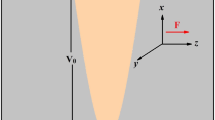Abstract
In this paper, we have calculated the band structure of strained quantum well (QW) semiconductor optical amplifiers (SOAs) by using plane wave expansion method (PWEM) and finite difference method (FDM), respectively. The difference between these two numerical methods is presented. First, the solution of Schrödinger’s equation in a conduction band for parabolic potential well is used to check the validity and accuracy of these two numerical methods. For the PWEM, its stability and computational speed are investigated as a function of the number of plane waves and the period of QW. For FDM, effects of mesh size and QW width on its accuracy and calculation time are discussed. Finally, we find that the computational speed of FDM generally is faster than that of PWEM. However, the PWEM is more efficient than the FDM when wider SOAs are needed to be calculated. Therefore, to obtain high accuracy and efficient numerical solutions for band structures, numerical methods should be selected depending on required accuracy, device structure and further applications.
Similar content being viewed by others
References
Huang X, Qin C, Huang D X, Zhang X L. Local carrier recovery acceleration in quantum well semiconductor optical amplifiers. IEEE Journal of Quantum Electronics, 2010, 46(10): 1047–1013
Meuer C, Schmidt-Langhorst C, Schmeckebier H, Fiol G, Arsenijević D, Schubert C, Bimberg D. 40 Gb/s wavelength conversion via four-wave mixing in a quantum-dot semiconductor optical amplifier. Optics Express, 2011, 19(4): 3788–3798
Meuer C, Schmidt-Langhorst C, Bonk R, Schmeckebier H, Arsenijević D, Fiol G, Galperin A, Leuthold J, Schubert C, Bimberg D. 80 Gb/s wavelength conversion using a quantum-dot semiconductor optical amplifier and optical filtering. Optics Express, 2011, 19(6): 5134–5142
Tan G L, Xu J M. Modeling of gain, differential gain, index change, and linewidth enhancement factor for strain-compensated QW’s. IEEE Photonics Technology Letters, 1998, 10(10): 1386–1388
Chang C S, Chuang S L, Lien C S. Modeling of strained quantum-well lasers with spin-orbit coupling. IEEE Journal on Selected Topics in Quantum Electronics, 1995, 1(2): 218–229
Liu Y, Tangdiongga E, Li Z, de Waardt H, Koonen A M J, Khoe G D, Shu X W, Bennion I, Dorren H J S. Error-free 320-Gb/s all-optical wavelength conversion using a single semiconductor optical amplifier. Journal of Lightwave Technology, 2007, 25(1): 103–108
Liu Y, Tangdiongga E, Li Z, Zhang S X, de Waardt H, Khoe G D, Dorren H J S. Error-free all-optical wavelength conversion at 160 Gb/s using a semiconductor optical amplifier and an optical bandpass filter. Journal of Lightwave Technology, 2006, 24(1): 230–236
Dong J J, Zhang X L, Xu J, Huang D X. 40 Gb/s all-optical logic NOR and OR gates using a semiconductor optical amplifier: experimental demonstration and theoretical analysis. Optics Communications, 2008, 281(6): 1710–1715
Mørk J, Mecozzi A. Response function for gain and refractive index dynamics in active semiconductor waveguides. Applied Physics Letters, 1994, 65(14): 1736–1738
Nielsen ML, Mørk J, Suzuki R, Sakaguchi J, Ueno Y. Experimental and theoretical investigation of the impact of ultra-fast carrier dynamics on high-speed SOA-based all-optical switches. Optics Express, 2006, 14(1): 331–347
Yamanaka T, Yoshikuni Y, Yokoyama K, Lui W, Seki S. Theoretical study on enhanced differential gain and extremely reduced linewidth enhancement factor in quantum-well lasers. IEEE Journal of Quantum Electronics, 1993, 29(6): 1609–1616
Harrison P. Quantum wells, wires, and dots. Theoretical and Computational Physics. West Sussex, UK: John Wiley & Sons, 2001
Chuang S L. Physics of Optoelectronic Devices. New York: Wiley-Interscience, 1995
Chao C Y P, Chuang S L. Spin-orbit-coupling effects on the valence-band structure of strained semiconductor quantum wells. Physical Review B: Condensed Matter and Materials Physics, 1992, 46(7): 4110–4122
Author information
Authors and Affiliations
Corresponding author
Rights and permissions
About this article
Cite this article
Huang, X., Qin, C. & Zhang, X. High accuracy numerical solutions for band structures in strained quantum well semiconductor optical amplifiers. Front. Optoelectron. China 4, 330 (2011). https://doi.org/10.1007/s12200-011-0220-3
Received:
Accepted:
Published:
DOI: https://doi.org/10.1007/s12200-011-0220-3




